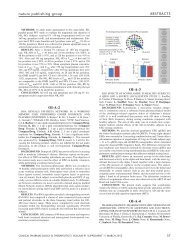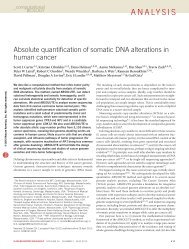open access: Nature Reviews: Key Advances in Medicine
open access: Nature Reviews: Key Advances in Medicine
open access: Nature Reviews: Key Advances in Medicine
Create successful ePaper yourself
Turn your PDF publications into a flip-book with our unique Google optimized e-Paper software.
(HNF-4α), a crucial regulator of gene expression<br />
<strong>in</strong> pancreatic islet β cells, have impaired<br />
glucose tolerance. In 2011, Sandovici et al.<br />
reported how maternal diet <strong>in</strong> rats affects the<br />
epigenetic regulation of the Hnf4a locus <strong>in</strong><br />
pancreatic islets of offspr<strong>in</strong>g. 2 The researchers<br />
found that a low-prote<strong>in</strong> maternal diet<br />
led to underexpression of Hnf4a <strong>in</strong> the islets<br />
of the offspr<strong>in</strong>g. Mechanistically, the underexpression<br />
could be attributed <strong>in</strong> part to<br />
his tone modifications at the gene enhancer<br />
region of Hnf4a, which led to changes <strong>in</strong><br />
chromat<strong>in</strong> loop<strong>in</strong>g that ultimately weakened<br />
the <strong>in</strong>teraction between the enhancer region<br />
and a specific promoter region. The normative<br />
age-dependent epigenetic silenc<strong>in</strong>g<br />
of the Hnf4a locus was exacerbated <strong>in</strong> rats<br />
exposed <strong>in</strong> utero to a low-prote<strong>in</strong> diet. These<br />
data add to the grow<strong>in</strong>g experimental literature<br />
show<strong>in</strong>g epigenetic consequences from<br />
the manipulation of early life undernutrition<br />
<strong>in</strong> metabolically relevant tissues.<br />
Previous studies <strong>in</strong> rats have shown that<br />
neonatal adm<strong>in</strong>istration of the adipok<strong>in</strong>e<br />
lept<strong>in</strong> can reverse developmental programm<strong>in</strong>g<br />
lead<strong>in</strong>g to metabolic compromise as<br />
well as some of the associated epi genetic<br />
changes. 3 Such studies are provocative<br />
<strong>in</strong> that they suggest that develop mental<br />
program m<strong>in</strong>g <strong>in</strong> humans might be reversible.<br />
P<strong>in</strong>ney et al. exam<strong>in</strong>ed how adm<strong>in</strong>istration<br />
of exenatide, an analogue of the<br />
<strong>in</strong>cret<strong>in</strong> glucagon-like peptide 1, acts to<br />
prevent the development of glucose <strong>in</strong>tolerance<br />
<strong>in</strong> adulthood <strong>in</strong> rats subjected to <strong>in</strong>trauter<strong>in</strong>e<br />
growth restriction. 4 Rats subjected<br />
to this abnormal <strong>in</strong>trauter<strong>in</strong>e environ ment<br />
develop glucose <strong>in</strong>tolerance and are characterized<br />
by progressive epi genetic silenc<strong>in</strong>g<br />
of pancreatic islet transcription factor<br />
Pdx1. The 2011 paper found that <strong>in</strong>jection<br />
of exenatide dur<strong>in</strong>g postnatal day 1–6 <strong>in</strong><br />
rats after <strong>in</strong>trauter<strong>in</strong>e growth restriction<br />
<strong>in</strong>creased Pdx1 transcription by normaliz<strong>in</strong>g<br />
post-translational and epigenetic changes<br />
© Paul Hakimata | Dreamstime.com<br />
<strong>Key</strong> advances<br />
related to this gene, <strong>in</strong>clud<strong>in</strong>g Pdx1 activator<br />
phosphorylation, histone acetylation and<br />
trimethylation, and DNA methylation at the<br />
CpG island <strong>in</strong> the Pdx1 promoter. Exenatide<br />
is already <strong>in</strong> use <strong>in</strong> the treatment of adults<br />
with type 2 diabetes mellitus (T2DM), and<br />
this study provides an experimental proof<br />
of concept for its usage early <strong>in</strong> life prior to<br />
disease onset.<br />
Prophylactic treatment of at-risk <strong>in</strong>dividuals<br />
early <strong>in</strong> life is generally more efficacious<br />
and provides greater health and cost<br />
benefits than treatment after a disease<br />
de velops. This is particularly the case for<br />
diseases such as diabetes mellitus, where<br />
the cost of treat <strong>in</strong>g associated morbidities<br />
and complica tions compounds over many<br />
years. How ever, beyond the obvious research<br />
program that would be needed to validate<br />
such <strong>in</strong>terventions, a challenge rema<strong>in</strong>s:<br />
how do we identify <strong>in</strong>fants whose particular<br />
developmental programm<strong>in</strong>g has placed<br />
them at <strong>in</strong>creased metabolic risk? Birth<br />
weight is not a satisfactory proxy, given that<br />
metabolically adverse developmental programm<strong>in</strong>g<br />
can occur <strong>in</strong>dependent of birth<br />
weight. 5 A recent paper by Godfrey et al.<br />
—to which I contributed—has suggested that<br />
the epigenetic state at birth can both predict<br />
childhood adiposity and be a measure of prenatal<br />
nutritional exposures. 6 Umbilical cord<br />
tissue-derived DNA was sourced from two<br />
<strong>in</strong>dependent large-scale prospective cohorts,<br />
and the methylation status at specific CpGs<br />
<strong>in</strong> the promoter region of RXRα, which<br />
encodes a transcription factor <strong>in</strong>volved <strong>in</strong><br />
fat metabolism and <strong>in</strong>sul<strong>in</strong> sensitivity, was<br />
measured after a prelim<strong>in</strong>ary genome-wide<br />
scan. A positive correlation between degree<br />
of RXRα methyla tion at one specific site <strong>in</strong><br />
the promoter and childhood body adiposity<br />
at age 6 years or 9 years was found <strong>in</strong><br />
both with<strong>in</strong>-cohort and between-cohort<br />
replicates. Additionally, a negative association<br />
was observed between mater nal carbohydrate<br />
<strong>in</strong>take dur<strong>in</strong>g the first tri mes ter of<br />
pregnancy and the degree of methylation at<br />
ENDOCRINOLOGY<br />
■ Changes <strong>in</strong> promoter–enhancer <strong>in</strong>teractions underlie the epigenetic regulation of a<br />
transcription factor <strong>in</strong> rat pancreatic islets <strong>in</strong>duced by poor maternal diet 2<br />
■ The trajectory towards onset of type 2 diabetes mellitus (T2DM) <strong>in</strong> the growth-compromised<br />
newborn rat can be reversed by an <strong>in</strong>cret<strong>in</strong> analogue that normalizes epigenetic<br />
modifications associated with pancreatic β-cell dysfunction 4<br />
■ Strong relationships exist between epigenotype at birth and later adiposity, and between<br />
maternal nutrition and offspr<strong>in</strong>g epigenotype <strong>in</strong> humans 6<br />
■ The epigenetic states of genes associated with T2DM and obesity might be a<br />
presymptomatic marker of the lifetime risk of T2DM <strong>in</strong> humans 7<br />
■ The phenotypic effects of early life overnutrition can be transgenerationally transmitted<br />
through the paternal l<strong>in</strong>e <strong>in</strong> mice 9<br />
this site. In contrast to the small effect sizes<br />
typically seen with genetic polymorp hisms<br />
associated with metabolic disease risk, this<br />
s<strong>in</strong>gle site epigenotype could account for<br />
at least 25% of the variance <strong>in</strong> child hood<br />
adipo sity. This association was obser ved<br />
across a healthy population, <strong>in</strong>dicat<strong>in</strong>g<br />
that develop mental programm<strong>in</strong>g of metabolic<br />
risk and associated epigenetic variation<br />
occurs across the normative range of<br />
developmental experiences.<br />
Genes for which polymorphisms have<br />
strong associations with disease risk might<br />
be anticipated to have epimutations (aberrant<br />
epigenetic marks). One such gene is<br />
FTO, which has been identified by genomewide<br />
association studies as be<strong>in</strong>g <strong>in</strong>volved<br />
<strong>in</strong> obesity risk. In a prospective study of<br />
nonsymptomatic <strong>in</strong>divi duals of a mean age<br />
of 30 years by Toperoff et al., 7 those who<br />
showed hypomethylation at an <strong>in</strong>tronic<br />
CpG site of FTO <strong>in</strong> blood samples had<br />
an <strong>in</strong>creased risk of develop <strong>in</strong>g impaired<br />
glucose metabolism by a mean age of<br />
43 years. This pattern was also seen <strong>in</strong> a<br />
sepa rate case–control analysis, although the<br />
level of hypomethylation <strong>in</strong> cases relative to<br />
controls was small, as was the effect size. 7<br />
These f<strong>in</strong>d<strong>in</strong>gs were made <strong>in</strong> a tissue not<br />
specifically related to metabolic function,<br />
and the differential methylation levels may<br />
have been established <strong>in</strong> early development<br />
before major cell differentiation had<br />
occurred, although this <strong>in</strong>ference is cont<strong>in</strong>gent<br />
on the long-term stability of the FTO<br />
epigenotype after its establishment. The<br />
methylation levels could not be expla<strong>in</strong>ed<br />
by the presence or absence of the risk allele,<br />
<strong>in</strong>dicat<strong>in</strong>g that their association with disease<br />
risk was <strong>in</strong>dependent of DNA sequence.<br />
Global prevalence of maternal obesity<br />
and ges tational diabetes mellitus is ris<strong>in</strong>g,<br />
and both are risk factors for the development<br />
of meta bolic disorder <strong>in</strong> offspr<strong>in</strong>g; 8<br />
there fore, the potential for an escalat<strong>in</strong>g<br />
prevalence of <strong>in</strong>tergenerationally <strong>in</strong>duced<br />
T2DM is a par ticular concern. Epigenetic<br />
KEY ADVANCES IN MEDICINE JANUARY 2012 | S27








